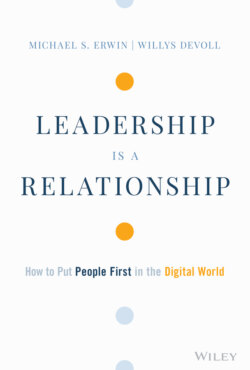Читать книгу Leadership is a Relationship - Michael S. Erwin - Страница 10
A Way Forward
ОглавлениеExamples of real-world leadership suggest a potent counter to the chaos of relationship complexity: a renewed commitment to people. Whereas technology so often pulls us away from the messy endeavor of relating to others, relationships pull us together and force us to engage with other minds, experiences, and hearts. Meaty relationships keep leaders from caring only about quarterly metrics and quantified measures of success; they're a call back toward the interpersonal and ethical parts of ourselves. Just as so many other powerful forces in our social and spiritual lives—like affection, loyalty, love, trust, and kindness—emerge from empathetic connection with others, so too does leadership. As the tumult of modern life creates lonelier lives, relationship-based leadership offers an antidote.
If this sounds simple, that's because it is. As a society, we just haven't decided to take relationships seriously. It's easy to replace the time-intensive behaviors that build relationships with quick texts and ephemeral messages; it's easy to replace a social lunch with a granola bar in front of the computer because we're “too busy getting work done.” With team members spread out over long distances, each working in physical isolation, forward-thinking leaders need compassionate solutions for entire teams now systemically deprived of face-to-face interaction with their peers. Even the most cynical, number-crunching leader can acknowledge that in a world where the job-for-life model is merely a vestige of the past, cultivating durable relationships is just good business. You never know who will pop back into your life.
The challenges of a device-centric world are huge, but the opportunity to reinvent modern relationships is huge, too. Whether your goal as a leader is to serve and inspire others, build and grow a successful organization, or both, we now know that digital shortcuts aren't shortcuts at all—they're inadequate substitutes for the work of community. Those leaders who have chosen to lead not with blunt authority, but instead with an unshakable commitment to the people around them, are creating environments of healthy growth and robust social impact. At work, their teams stay longer, work harder, and thrive. Leaders who don't have traditional authority or a formal leadership role can win hearts, minds, and loyalty while making progress toward auspicious goals. Relationship-based leadership is working for the bottom line and for people, and it's muffling the noise of our nonstop technoworld.
In this book, we'll share stories and tested tips for building a culture of relationships in the twenty-first century. We're not here to summarize the latest findings in psychology or sociology; we're here to showcase examples of how this kind of leadership actually works. We've spoken with role models from a variety of backgrounds, and whose accomplishments take many forms. We've interviewed educators, military officers, and athletes. Some are CEOs and generals, but most aren't. Some don't even readily refer to themselves as leaders. What they have in common is a core belief that other people matter, and that real leadership starts with that premise. Whereas some people are motivated by a title or power, the leaders in this book approach leadership as a natural result of their dedication to the people in their lives. They are, fundamentally, people looking to serve.
Their stories also show how leading with relationships has major benefits in seven key areas, each of which has its own chapter:
Accountability
Forgiveness
Resilience
Trust
Coalition-building
Loyalty
Stability
By the time you've reached the end of the book, you'll have new strategies with which you, too, can lead through the strength of your connection to others. At the end of each story, we highlight one key lesson to take back to your life. At the end of each chapter, we also give you key takeaways and questions for reflection, which you can use to start creating a personalized plan for maturing your own practice of leadership.
You can read this book cover to cover, and we hope that you do. But you can also skip between chapters, focusing on the topics that you're most curious about. We've designed this book as an ongoing resource for you. Just crack it open to whichever topic you want to revisit, and think about how your answers to the questions for reflection might have changed over time.
***
While we're confident that relationship-based leadership is effective, moral, and fulfilling, we're also confident that it gives every single person the license to lead. Legend has it that Dwight Eisenhower defined leadership as the art of getting someone to do something that you want done because they want to do it. In this approach, leaders still have clearly defined goals, and they still need the people around them to work toward those goals. But this leadership style doesn't appeal to formal authority or coercion; instead, it depends on the leader's ability to persuade, motivate, and create common purpose. Whatever's on your business card, you can lead if you can inspire people to act.
When leadership is understood as a series of relationships, no person is excluded from the privilege and responsibility of leading. You may or may not have a big desk in the corner office or make policy decisions that affect thousands of lives. You are, however, surrounded by people with whom you can forge empowering bonds; you can inspire others with your compassion, talent, and commitment; and you can improve others' lives by engaging in their stories, emotions, and beliefs.
That's all a way of saying something that seems so simple, but is also rich, challenging, and full of urgent promise: leadership is a relationship.
